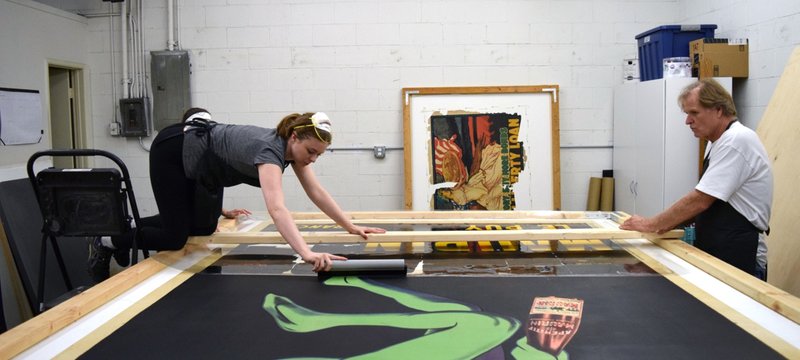Linen Backing Posters

Posters have been printed on inexpensive paper throughout their short history. This paper was often made using inferior materials like acidic wood pulp and unfiltered river water. The chemical nature of these materials tends to deteriorate over time. The paper becomes brittle and flaky. Folds, edges and tears turn brown. The chemical impurities oxidize, causing unsightly spots. All that will happen without human help. People often put tape on the backs of their posters. They store their posters in damp basements or attics where mildew can take hold or bug damage can occur. A poster can spend a short amount of time around cigarette smoke which will turn the paper brown. Fire smoke can be disastrous even if the poster doesn’t burn. There are many ways a poster can be damaged, and even without damage the paper will almost always deteriorate over time.
This is why linen backing is helpful. When a poster is linen backed, it is mounted to heavy canvas and acid free paper using an archival and reversible paste. These materials help slow the chemical deterioration of the poster’s paper. The backing further serves as a physical substrate for the weak and brittle poster. The poster is less prone to movement, less vulnerable to the elements, folds are stabilized and tears are mended. Surface irregularities are smoothed so that the viewers’ focus can be shifted toward the art and away from the deterioration.
During the linen backing process, the poster will be cleansed of impurities using a gentle aqueous process. If so desired the paper can also be bleached to treat any mildew growth or acid discoloration. The bleach used by paper conservators is designed to only affect the paper and never the printing ink, though the brightening of the paper can make the ink appear brighter.
After a poster is linen backed it is smooth, flat, and able to be safely rolled for storage or unrolled for display. It still may have visual blemishes though. This is where restoration can help. Linen backing and restoration almost always happen in the same studio. Holes are mended using acid free and archival paper or filler. Fold lines and visible tears are restored using reversible and acid free media like watercolors and colored pencils. In extreme cases, airbrushing can be used to mask large stains or to replicate missing paper. Restoration should always be reversible, archival, and acid free, but the extent of restoration can be negotiated according to the desires of the owner. Some prefer a flawless appearance and others prefer a minimal approach.
Care should be taken when looking for a restorer. It is a good idea to ask around and see who has a good reputation rather than going for the least expensive option. Remember that all this work is done by hand, by experts in their field. Take a moment to think about what the poster’s current condition is, and how you’d like it to look. Will you keep it stored or put it on display in your home? Get in touch with a few different linen backers and explain your ideas and wants and listen to what they have to say. Be sure to ask about their materials. Are they acid free, archival and reversible? You don’t want the poster’s appearance to change over time because of inferior restoration materials.You do want the backing to be reversible in case of future damage such as flood, fire, or shipping mishaps. Communication is key with your restorer.
Courtesy of IVPDA member Fourth Cone Restoration